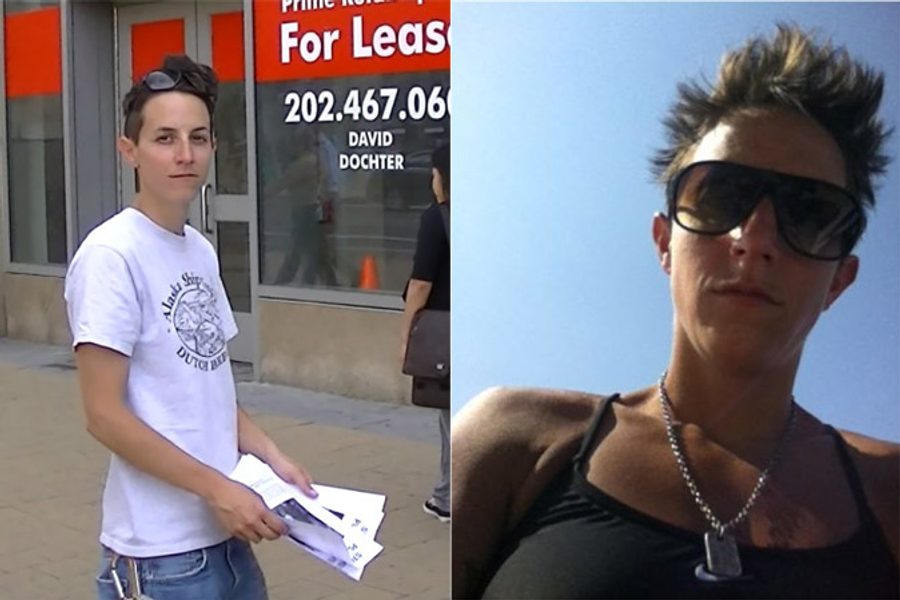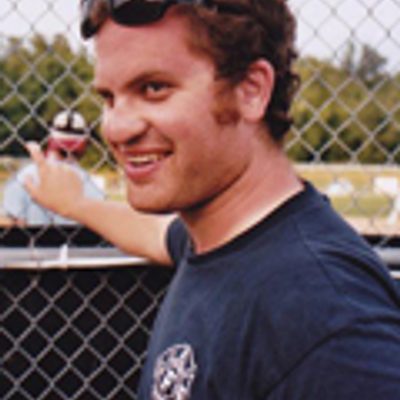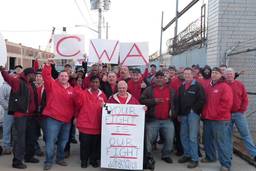Rumors have flown for many years that DC police routinely infiltrate and spy on the frequent protests in the nation’s Capitol. But until now, activists have never been able to identify a specific undercover cop at a protest. Now, after months of piecing together evidence, attorneys Jeffrey Light and Sean Canavan working with United Students Against Sweatshop (USAS) have confirmed that under an assumed name, Metro police officer Nicole Rizzi has participated in USAS protests against companies doing business in Bangladesh who refuse to sign the Accord on Fire and Building Safety in Bangladesh following the death of as many as 1,129 workers in the Rana Plaza factory collapse.
USAS and its lawyers have numerous pieces of evidence placing Rizzi at protests under a pseudonym. District of Columbia Public Employee Information List records obtained by In These Times confirm that Rizzi has been on the DC Metropolitan Police Department (MPD) force since December of 2003.
USAS filed suit on Monday against the District of Columbia seeking an injunction to stop police from spying on the group’s activities.
The story of how Rizzi was uncovered reads like a mix of “Gossip Girl” and “The Wire.” Activists pieced her identity together from her obsessive posting to social media sites, including Twitter, Tumblr, Instagram, Facebook, Wordpress and Yfrog.
Lacy MacAuley, an activist and media manager for the Institute for Policy Studies, has suspected for the past several years that a protester named “Missy” was an undercover cop. “Missy” seemed to be at every protest, but no one knew her. However, MacAuley had no way of proving her suspicions.
Then, in November of 2012, MacAuley was at a bar on U Street when a friend recommended that she follow a Twitter account of a funny person with the handle @snufftastic. MacAuley immediately identified the user in the photographs as the person she knew as “Missy.” The user Tweeted frequently about the daily grind of being a police officer in DC.
MacAuley says she then spotted Rizzi as “Missy” at an anti-Keystone pipeline protest at the Canadian Embassy on March 21, 2013. That was when MacAuley decided to approach Jeffrey Light, an attorney who works on police misconduct issues, with her suspicions. Light and his law partner Sean Canavan began searching for evidence to peg Rizzi as an undercover police officer.
The trickiest part was establishing Rizzi’s real name. But on @snufftastic, she let clues drop. On August 2, 2012, she Tweeted, “They used to call me No Sweat Nico because no matter how hot it was at academy, I never sweat.”

Light and Canavan did a public database search of all police officers in D.C. and found only two named Nicole; one was Rizzi. Photos on “Nicole Rizzi”’s Facebook account matched those on the @snufftastic Twitter and Instagram.
Moreover, a post on Rizzi’s since-deleted Tumblr account seemed to indicate that Rizzi worked undercover. In response to a post from a reader asking her how flexible her dress code was as a police officer, Rizzi said she wore “ordinary clothes,” but made a distinction between her position and that of a “plainclothes” patrol cop: “In the position I’m in, it’s beneficial to wear ordinary clothes. Plainclothes assignments too, you wear what would blend in.”
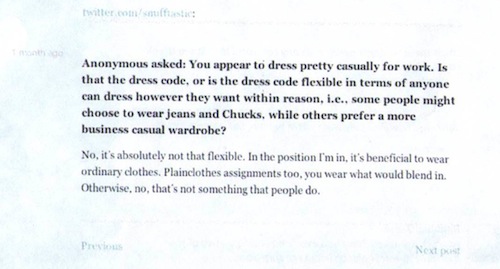
On April 20, MacAuley spotted “Missy” at a protest outside of the World Bank and snapped a photograph of her (above left). Meanwhile, Light and Canavan dug up evidence that Rizzi was a police officer, including a photograph posted on yfrog of Rizzi pointing out a typo on a piece of mail addressed to the “DC Metropolation [sic] Police Department.” Rizzi’s finger partially covers up the address line, but it appears to read “Director, Intelligence Branch.”
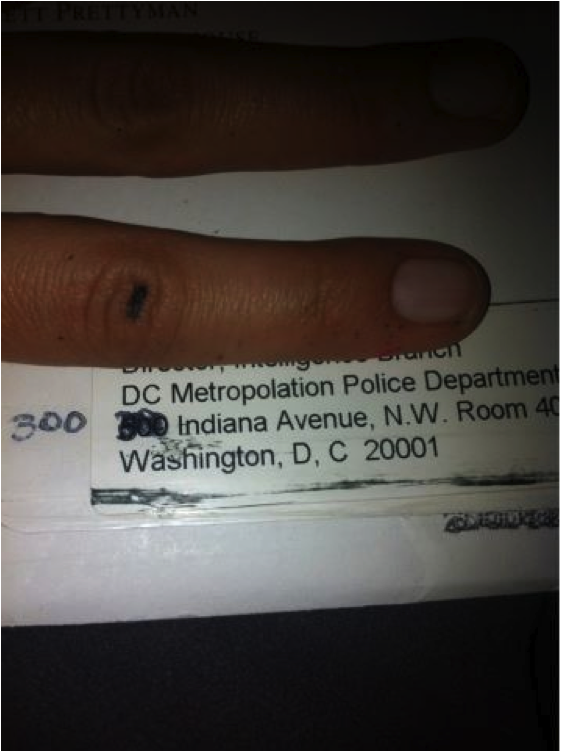
Light then began searching for a plaintiff who would have standing to file a complaint against Rizzi for spying. On May 15, Light happened to be walking by a USAS protest outside a Children’s Place clothing store in the Columbia Heights neighborhood of D.C. when he spotted Rizzi handing out protest flyers.
Light flagged down USAS organizer Garrett Shishido Strain and alerted him to Missy’s presence. Shishido Strain knew just how “Missy” had wound up at the protest: He had met her four days earlier at a USAS protest outside of a Gap. Rizzi identified herself as “Missy Thompson,” gave Shishido Strain her email and phone number, and asked to be informed of future actions so that she could attend. On May 14, Shishido Strain emailed her about a last-minute protest at the Children’s Place in Columbia Heights the next day.
Having been alerted by Light, Shishido Strain and other activists filmed Rizzi handing out flyers at the May 15 like a normal protester. Later, Shishido Strain would spot Rizzi once more, at a June 29 protest against the Gap.
In retrospect, Shishido Strain believes that Rizzi had notified DC police about the group’s plans. “One of the steps we usually take at our protest is to deliver a letter detailing the human rights abuses in their supply chain to the store/business being protested,” says Shishido Strain. “We do not break any laws and if we are asked to leave the store after delivering the letter, we do. After ‘Missy’ began participating in our events, we were twice blocked from delivering letters by the Metropolitan Police Department, who presumably had been tipped off about the time and location of our events. This occurred at the May 15 Children’s Place demonstration and the June 29 demonstration.”
A law enacted by the D.C. Council in 2004 imposes strict guidelines on police when they investigate or attempt to infiltrate First Amendment-protected groups. The Police Investigations Concerning First Amendment Activities Act of 2004 specifies that the MPD departments can only investigate free speech activities if they can prove sufficient cause that protestors are engaged in crime and they have the authorization of the Executive Director of the DC MPD Intelligence Fusion Divisions (or an appropriate supervisor of similar rank). To send in undercover officers, they have to go through the same authorization process again.
But USAS attorneys Sean Canavan and Jeffrey Light say the MPD rarely follows this law. To wit, a 2012 investigation of the department by the Office of the District of Columbia Auditor concluded that the DC police failed to obtain authorization for 16 of 20 investigations into protest groups between January of 2005 and November 21, 2011. (Another seven cases were open during this period, but the files were destroyed before the review.) The report also found that the MPD never obtained official permission to send in undercover officers to protests, but did so in 17 cases.
The DC Metropolitan Police Department did not return request for comment. However, in response to the audit in 2012, DC MPD Chief Cathy L. Lainer wrote, the “MPD contends that the Intelligence Branch has consistently gone far beyond what is required by the Act.”
Light, who filed the case on behalf of USAS, says that undercover surveillance sows suspicion among activists and hinders collective action.
“If they are putting an undercover [cop] there, then they are putting undercover [police] everywhere. That is a big problem for a lot of these groups,” says Light. “You are trying to get people to come out and protest knowing that there is a undercover cop there — it’s a huge problem.”
Shishido Strain says his run-ins with Rizzi have already made him wary of strangers who want to get involved in fights for workers’ rights.
“I have personally become much more cautious with people who express support for us at actions and others who express an interest in joining our actions, if I do not know them already,” he says.
